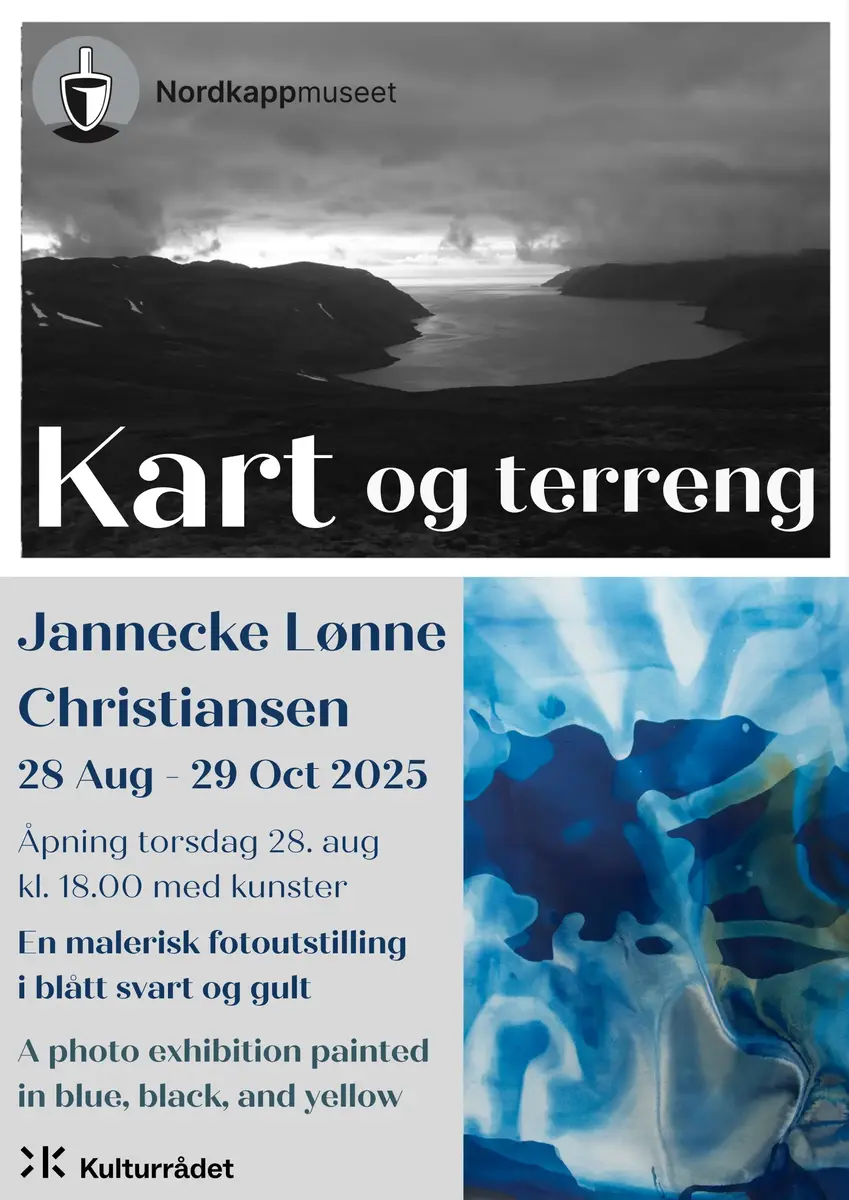Map and Terrain
a painterly photo exhibition in blue, black and yellow
by Jannecke Lønne Christiansen
Jannecke Lønne Christiansen, visual artist educated in Bergen and Trondheim and currently based in Lillehammer, presents experimental cyanotypes and black-and-white photography at the North Cape Museum. She works with painting, photography, installation, and artist books. She has exhibited extensively in Norway and abroad, and has participated in site-specific projects such as K-Lab in Kjerringøy, in Uppsala, and in Estonia. Her work has been shown at Lillehammer Art Museum, the Peder Balke Center, among others. Her most recent solo exhibition was at the Norwegian Forest Museum in Elverum.
She says about her own work:
For years I have been working with cyanotype, a camera-less photographic technique where chemicals behave more like painting. The cyanotype technique consists of mixing two salts with water and applying this solution to a surface that becomes light-sensitive like photographic paper. By exposing the paper to ultraviolet rays and then rinsing it with water, you obtain a blue image. The blue image can be manipulated in different ways to expand the color range. The photographic technique cyanotype was discovered by Sir John Herschel in 1842. The English botanist and photographer Anna Atkins (1799–1871) was one of the first to use it. In her research, Anna Atkins registered plants as photograms using cyanotype.
For the exhibition in Honningsvåg, which I have titled Map and Terrain, I want to explore how landscape, biology, geology, and human encounters influence and become part of the images – both in cyanotype and in black-and-white photography. Some of the works will
be created on-site in August 2025, and others as a memory work from a stay in Finnmark in 2024.
The exhibition will be divided into two parts – one with nature-inspired painterly cyanotypes, and one with black-and-white photography.
Working in unfamiliar terrain requires an intense presence to see more than just the surface. I am fascinated by the landscape, its geological and historical background, and how today it transforms into tourist spots, while at the same time being everyday life for those who live here. I will photograph nature, places, and traces of human presence, and create cyanotypes directly in the landscape, with objects and plants.
With Map and Terrain one might expect a documentary representation, but by abstracting the experiences – such as the mighty landscape, the shifting weather, the sea, and the light – I want to give the viewer space to weave in their own experiences. I will also create a travel book where I register my “findings” and thoughts through drawings and cyanotypes, which will be bound and presented at the exhibition.
In cyanotype I have moved from depiction and representation toward abstraction, where the movement of the chemicals, the length of exposure, the amount of water or other substances, create the expression. The movement of water – soft and gentle, or agitated and powerful – leaves traces like the photographic moment, yet flowing like a watercolor, like a painting. I am concerned with the fleeting nature of existence, the ceaseless movement of time, where the river is never the same, and where the movement of light, day, and seasons is what we can hold on to. I work wet-in-wet, where cyanotype’s blue becomes stronger or weaker with more or less water, manipulating the chemicals and adding biological colors (boiling color “soups” from plants) to approach nature’s processes and transformations. I also explore how cyanotype can be used in three dimensions.
In parallel I work with black-and-white photography. In these images, I seek a poetically abstracted approach, but within the documentary reference of photography, human experiences come through. With the choice of light and shadow, black and white, weight and lightness – the photograph tells as much about force, time, and vulnerability as about the specific place and moment in which it was taken.
Working site-specifically also carries responsibility. A responsibility to show from which perspective you see, and the attitudes you bring with you. I have previously worked extensively with site-specific art in the form of outdoor installations – this reading of the surroundings will now use photography as a tool in different ways.
I hope that by using these two parallel approaches – cyanotype and black-and-white photography – I will be able to highlight the way I see the world, both as outer form and as inner experience – both with Finnmark under my skin.
- 1/1
